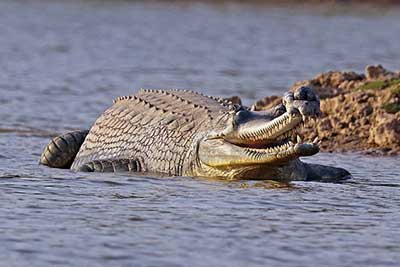Relevance: GS-3 :Conservation, environmental pollution and degradation, environmental impact assessment.
Key Phrases: Gharial Reintroduction Project, Beas conservation Reserve, WWF India, Chambal wildlife santuary
Why in News?
- After successfully reintroducing the critically endangered Gharial in the rivers of Punjab where it had become extinct half a century ago, the State’s wildlife preservation wing is now keeping its fingers crossed, expecting the breeding of the crocodilians to start in the new few years as the released gharials are healthy and have adapted to the Beas Conservation Reserve as their home.
What is Gharial Reintroduction Project?
- WWF-India has been involved in the Species Recovery Programme ever since the National Chambal Gharial crisis in December 2007.
- In collaboration with the Uttar Pradesh Forest Department, WWF-India started a gharial reintroduction programme at Hastinapur Wildlife Sanctuary. Since January 2009, 250 captive reared gharial from Kukrail Rehabilitation Centre (Lucknow) have been released into River Ganga.
- Under the gharial reintroduction project at the Beas conservation reserve in the northern state, 25 more gharials were sent from the Chambal gharial hatchery in Morena district. The hatchery has been successfully involved in conservation of the endangered reptile since the past 40 years.
- Punjab started this project in the year 2017 with a target of releasing 100 reptiles in four years. The gharial reintroduction project of the Punjab forests and wildlife preservation department in association with World Wildlife Fund (WWF), India, aims to establish a breeding population of the species in the state's rivers.
Beas Conservation Reserve
- The Beas Conservation Reserve is a 185-kilometre stretch of the Beas River located primarily in the north-west of the State of Punjab. The River meanders down from the Himalayan foothills to the Harike Headworks, where its course is diverted into a number of channels. The River is dotted with islands, sand bars and braided channels creating a complex environment supporting substantial biodiversity.
- The Reserve also hosts the only known population in India of the endangered Indus river dolphin. Further threatened species include the endangered masheer and hog deer as well as the vulnerable smooth-coated otter.

Gharial:
- The gharial (Gavialis gangeticus), also known as the gavial or the fish-eating crocodile, is a crocodilian in the family Gavialidae and among the longest of all living crocodilians.
- Mature females are 2.6–4.5 m long, and males 3–6 m.
- Adult males have a distinct boss at the end of the snout, which resembles an earthenware pot known as a ghara, hence the name "gharial".
- Population of Gharials are a good indicator of clean river water.
- The gharial probably evolved in the northern Indian subcontinent. Fossil gharial remains were excavated in Pliocene deposits in the Sivalik Hills and the Narmada River valley.
- It currently inhabits rivers in the plains of the northern part of the Indian subcontinent. It is the most thoroughly aquatic crocodilian, and leaves the water only for basking and building nests on moist sandbanks.
- Adults mate at the end of the cold season. Females congregate in spring to dig nests, in which they lay 20–95 eggs. They guard the nests and the young, which hatch before the onset of the monsoon.
- The hatchlings stay and forage in shallow water during their first year, but move to sites with deeper water as they grow.
Habitat and Distribution:
- Gharial prefers deep fast flowing rivers, however adult gharial have also been observed in still water branches (jheel) of rivers and in comparatively velocity-free aquatic environments of deepholes (kunds) at river bends and confluences. Smaller animals seem to conserve energy by resting out of the mainstream in sheltered backwaters, particularly during the monsoon (July-September).
- Sand and rock outcrops are preferred basking sites and these animals show considerable site fidelity. Historically, gharial were found in the river system of India, Pakistan, Bangladesh and southern part of Bhutan and Nepal.
- Today they survive only in the waters of India and Nepal. The surviving population can be found within the tributaries of the Ganges river system: Girwa (Uttar Pradesh), Son (Madhya Pradesh), Ramganga (Uttarakhand), Gandak (Bihar), Chambal (Uttar Pradesh, Madhya Pradesh and Rajasthan) and Mahanadi (Orissa).
World Wide Fund for Nature
- The World Wide Fund for Nature is an international non-governmental organization founded in 1961 that works in the field of wilderness preservation and the reduction of human impact on the environment. It was formerly named the World Wildlife Fund, which remains its official name in Canada and the United States.
Source: The Hindu
Mains Question:
Q. Recently Government of Punjab has released Gharials in the Beas River for the conservation and protection in natural habitat. In this context what is Gharial Reintroduction Programme? What is the issue related to conservation and protection of gharial in their natural habitat?









